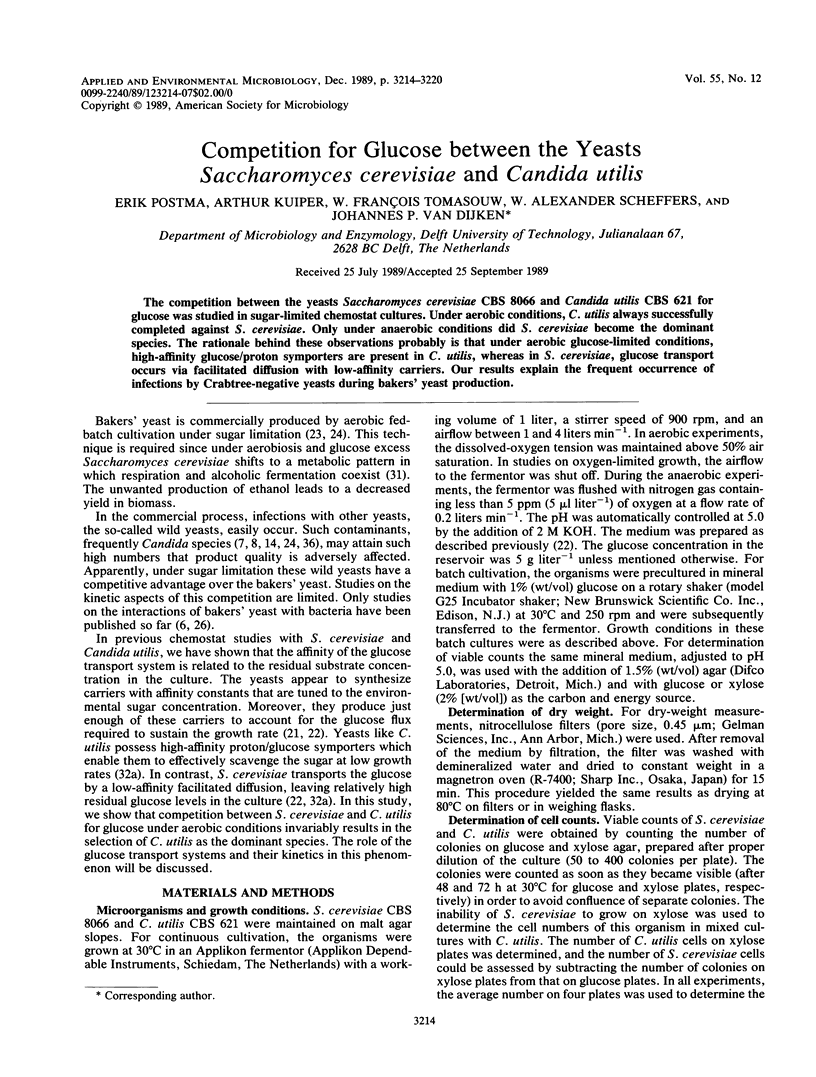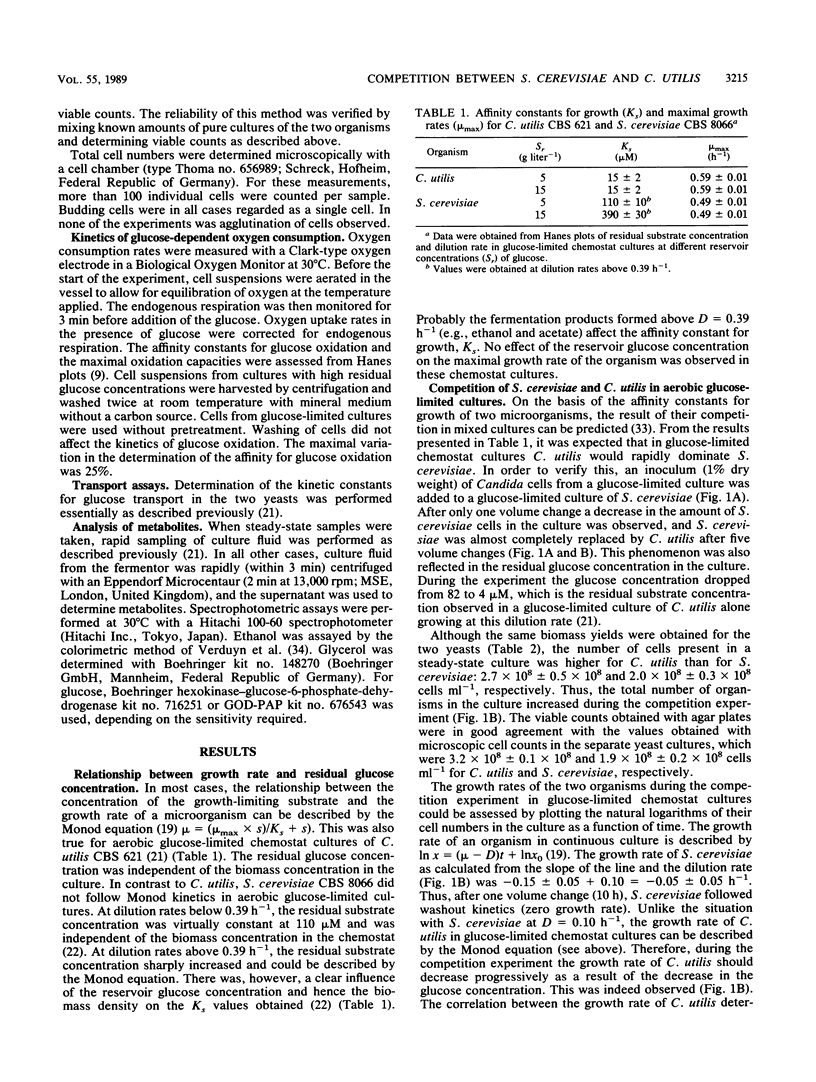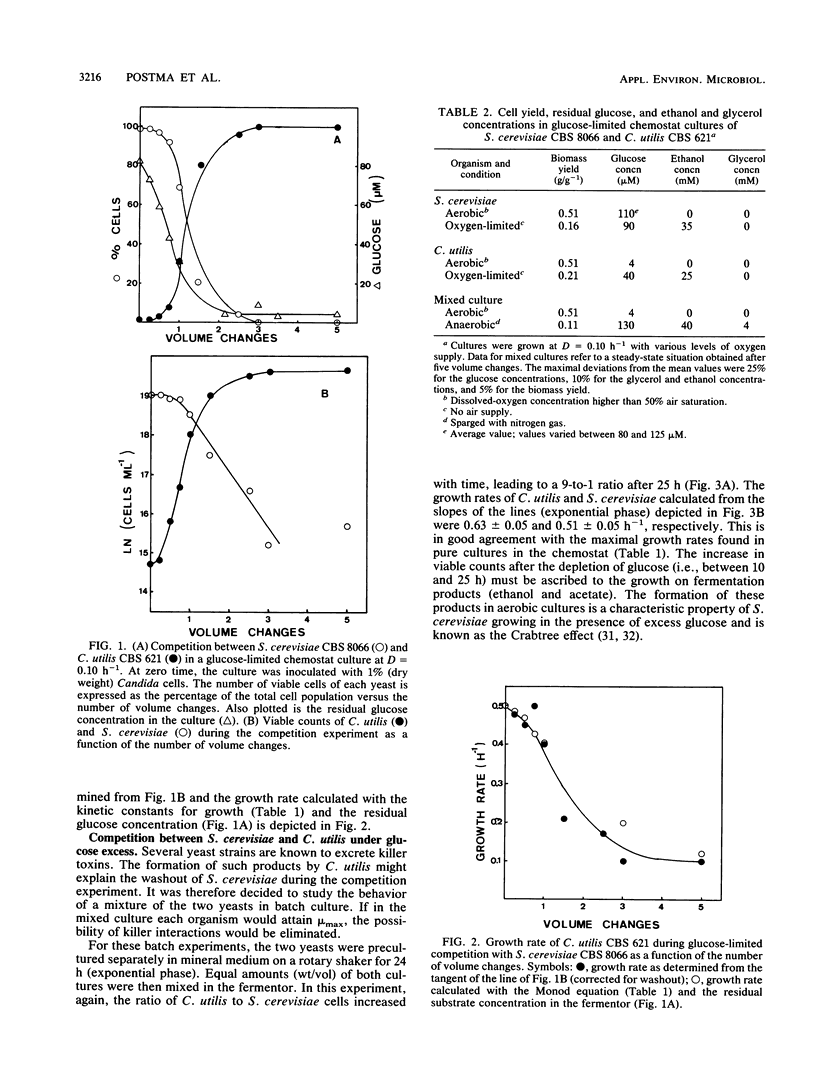Abstract
The competition between the yeasts Saccharomyces cerevisiae CBS 8066 and Candida utilis CBS 621 for glucose was studied in sugar-limited chemostat cultures. Under aerobic conditions, C. utilis always successfully completed against S. cerevisiae. Only under anaerobic conditions did S. cerevisiae become the dominant species. The rationale behind these observations probably is that under aerobic glucose-limited conditions, high-affinity glucose/proton symporters are present in C. utilis, whereas in S. cerevisiae, glucose transport occurs via facilitated diffusion with low-affinity carriers. Our results explain the frequent occurrence of infections by Crabtree-negative yeasts during bakers' yeast production.
Full text
PDF






Selected References
These references are in PubMed. This may not be the complete list of references from this article.
- ANDREASEN A. A., STIER T. J. B. Anaerobic nutrition of Saccharomyces cerevisiae. I. Ergosterol requirement for growth in a defined medium. J Cell Physiol. 1953 Feb;41(1):23–36. doi: 10.1002/jcp.1030410103. [DOI] [PubMed] [Google Scholar]
- ANDREASEN A. A., STIER T. J. Anaerobic nutrition of Saccharomyces cerevisiae. II. Unsaturated fatty acid requirement for growth in a defined medium. J Cell Physiol. 1954 Jun;43(3):271–281. doi: 10.1002/jcp.1030430303. [DOI] [PubMed] [Google Scholar]
- Beck C., von Meyenburg H. K. Enzyme pattern and aerobic growth of Saccharomyces cerevisiae under various degrees of glucose limitation. J Bacteriol. 1968 Aug;96(2):479–486. doi: 10.1128/jb.96.2.479-486.1968. [DOI] [PMC free article] [PubMed] [Google Scholar]
- Bisson L. F. High-affinity glucose transport in Saccharomyces cerevisiae is under general glucose repression control. J Bacteriol. 1988 Oct;170(10):4838–4845. doi: 10.1128/jb.170.10.4838-4845.1988. [DOI] [PMC free article] [PubMed] [Google Scholar]
- Goncharova L. A., Bocharova N. N., Kobrina Iu P., Zvigur E. S. Vliianie drozhzhepodobnykh gribov na vykhod i kachestvo pekarskikh drozhzei. Mikrobiologiia. 1965 Jan-Feb;34(1):157–162. [PubMed] [Google Scholar]
- HOLZER H., BERNHARDT W., SCHNEIDER S. [On glycerin formation in baker's yeast]. Biochem Z. 1963;336:495–509. [PubMed] [Google Scholar]
- Hanes C. S. Studies on plant amylases: The effect of starch concentration upon the velocity of hydrolysis by the amylase of germinated barley. Biochem J. 1932;26(5):1406–1421. doi: 10.1042/bj0261406. [DOI] [PMC free article] [PubMed] [Google Scholar]
- Heard G. M., Fleet G. H. Occurrence and Growth of Killer Yeasts during Wine Fermentation. Appl Environ Microbiol. 1987 Sep;53(9):2171–2174. doi: 10.1128/aem.53.9.2171-2174.1987. [DOI] [PMC free article] [PubMed] [Google Scholar]
- Panchal C. J., Meacher C., Van Oostrom J., Stewart G. G. Phenotypic expression of Kluyveromyces lactis killer toxin against Saccharomyces spp. Appl Environ Microbiol. 1985 Aug;50(2):257–260. doi: 10.1128/aem.50.2.257-260.1985. [DOI] [PMC free article] [PubMed] [Google Scholar]
- Pfeiffer P., Radler F., Caspritz G., Hänel H. Effect of a killer toxin of yeast on eucaryotic systems. Appl Environ Microbiol. 1988 Apr;54(4):1068–1069. doi: 10.1128/aem.54.4.1068-1069.1988. [DOI] [PMC free article] [PubMed] [Google Scholar]
- Polakis E. S., Bartley W., Meek G. A. Changes in the activities of respiratory enzymes during the aerobic growth of yeast on different carbon sources. Biochem J. 1965 Oct;97(1):298–302. doi: 10.1042/bj0970298. [DOI] [PMC free article] [PubMed] [Google Scholar]
- Postma E., Scheffers W. A., van Dijken J. P. Kinetics of growth and glucose transport in glucose-limited chemostat cultures of Saccharomyces cerevisiae CBS 8066. Yeast. 1989 May-Jun;5(3):159–165. doi: 10.1002/yea.320050305. [DOI] [PubMed] [Google Scholar]
- SHINDALA A., BUNGAY H. R., 3rd, KRIEG N. R., CULBERT K. MIXED-CULTURE INTERACTIONS. I. COMMENSALISM OF PROTEUS VULGARIS WITH SACCHAROMYCES CEREVISIAE IN CONTINUOUS CULTURE. J Bacteriol. 1965 Mar;89:693–696. doi: 10.1128/jb.89.3.693-696.1965. [DOI] [PMC free article] [PubMed] [Google Scholar]
- Verma R. S., Spencer-Martins I., Van Uden N. Role of de novo protein synthesis in the interconversion of glucose transport systems in the yeast Pichia ohmeri. Biochim Biophys Acta. 1987 Jun 12;900(1):139–144. doi: 10.1016/0005-2736(87)90285-9. [DOI] [PubMed] [Google Scholar]
- Witt I., Kronau R., Holzer H. Repression von Alkoholdehydrogenase, Malatdehydrogenase, Isocitratlyase und Malatsynthase in Hefe durch Glucose. Biochim Biophys Acta. 1966 Jun 15;118(3):522–537. [PubMed] [Google Scholar]
- van Urk H., Postma E., Scheffers W. A., van Dijken J. P. Glucose transport in crabtree-positive and crabtree-negative yeasts. J Gen Microbiol. 1989 Sep;135(9):2399–2406. doi: 10.1099/00221287-135-9-2399. [DOI] [PubMed] [Google Scholar]


